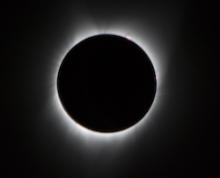AM Broadcast Observations of 2017 Solar Eclipse from Western America
AM Broadcast Observations of 2017 Solar Eclipse from Western America

HamSCI contributor Nick Hall-Patch, VE7DXR, presents observations of changes in AM Broadcast propagation during the 21 August 2017 Total Solar Eclipse. Full text of the article is available here.
This article starts with a brief description of historical observations that have been made concerning the effects of solar eclipses on the strengths of distant medium wave signals. It continues with a description of how medium-wave DXers used software defined radios (SDRs) for the first time during the solar eclipse of August 2017 to record the entire AM broadcast band (535-1705kHz) for later analysis. Although no plan had been made to create a formal experiment, it appears to be possible to use the data collected to analyze the effect of the eclipse on radio propagation. An example is presented, derived from recordings made at four different receiver locations in western North America, describing large variations in the signal strength from Salt Lake City's KSL-1160kHz during the course of the eclipse. The times that peak signal strengths occurred at the four locations are then compared relative to the times of eclipse totality along the signal paths.
Nick Hall-Patch, VE7DXR, has been a radio amateur since 1989, but for many years previous to that, had been interested in medium-wave DXing, particularly in the propagation of medium-wave signals from other continents. This interest has continued to the present day, though conclusions about propagation have not come as easily as observations. Prior to retirement, Nick assisted oceanographic researchers by designing, building, modifying and maintaining electronic instrumentation.
